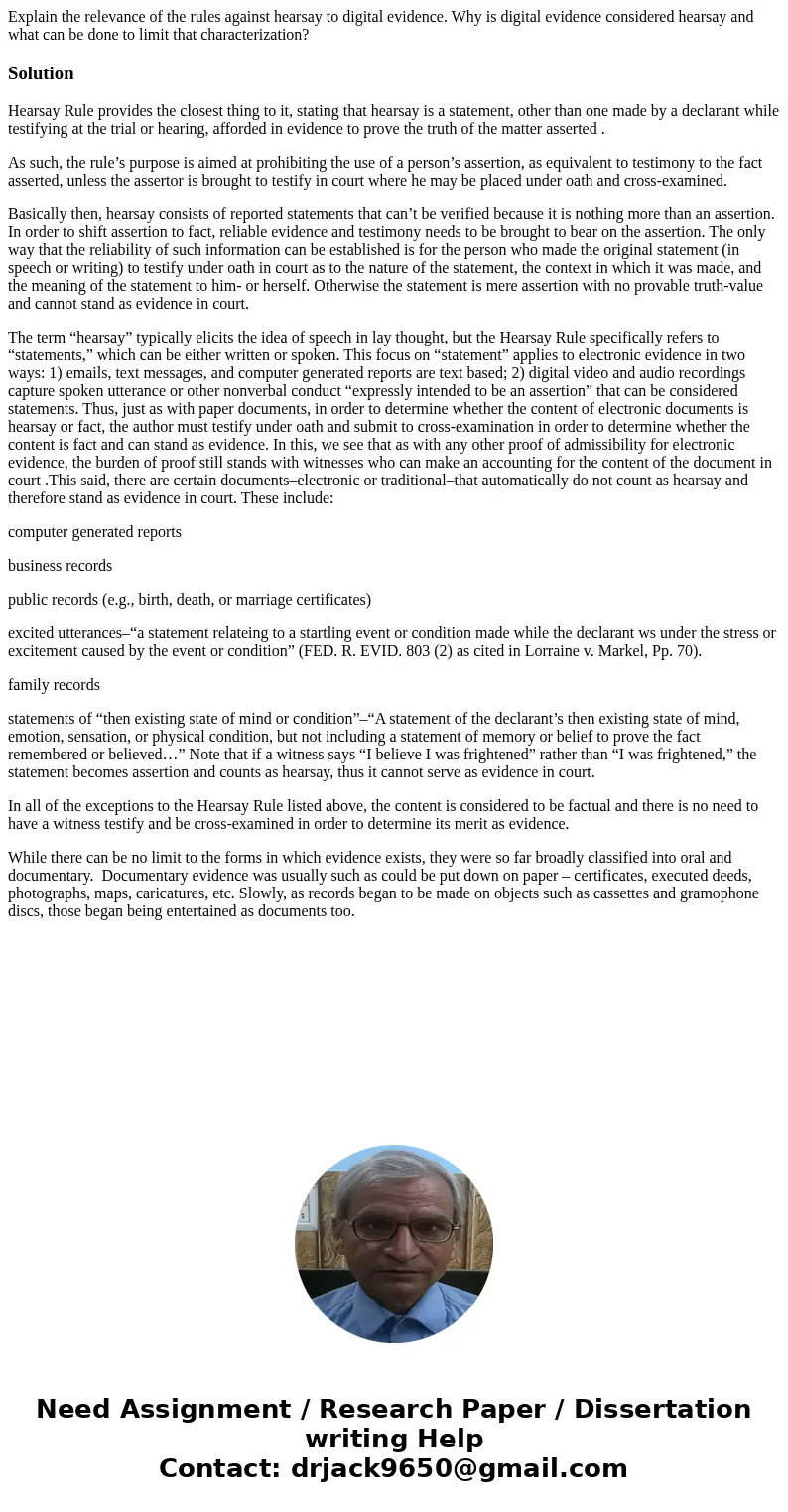Explain the relevance of the rules against hearsay to digita
Explain the relevance of the rules against hearsay to digital evidence. Why is digital evidence considered hearsay and what can be done to limit that characterization?
Solution
Hearsay Rule provides the closest thing to it, stating that hearsay is a statement, other than one made by a declarant while testifying at the trial or hearing, afforded in evidence to prove the truth of the matter asserted .
As such, the rule’s purpose is aimed at prohibiting the use of a person’s assertion, as equivalent to testimony to the fact asserted, unless the assertor is brought to testify in court where he may be placed under oath and cross-examined.
Basically then, hearsay consists of reported statements that can’t be verified because it is nothing more than an assertion. In order to shift assertion to fact, reliable evidence and testimony needs to be brought to bear on the assertion. The only way that the reliability of such information can be established is for the person who made the original statement (in speech or writing) to testify under oath in court as to the nature of the statement, the context in which it was made, and the meaning of the statement to him- or herself. Otherwise the statement is mere assertion with no provable truth-value and cannot stand as evidence in court.
The term “hearsay” typically elicits the idea of speech in lay thought, but the Hearsay Rule specifically refers to “statements,” which can be either written or spoken. This focus on “statement” applies to electronic evidence in two ways: 1) emails, text messages, and computer generated reports are text based; 2) digital video and audio recordings capture spoken utterance or other nonverbal conduct “expressly intended to be an assertion” that can be considered statements. Thus, just as with paper documents, in order to determine whether the content of electronic documents is hearsay or fact, the author must testify under oath and submit to cross-examination in order to determine whether the content is fact and can stand as evidence. In this, we see that as with any other proof of admissibility for electronic evidence, the burden of proof still stands with witnesses who can make an accounting for the content of the document in court .This said, there are certain documents–electronic or traditional–that automatically do not count as hearsay and therefore stand as evidence in court. These include:
computer generated reports
business records
public records (e.g., birth, death, or marriage certificates)
excited utterances–“a statement relateing to a startling event or condition made while the declarant ws under the stress or excitement caused by the event or condition” (FED. R. EVID. 803 (2) as cited in Lorraine v. Markel, Pp. 70).
family records
statements of “then existing state of mind or condition”–“A statement of the declarant’s then existing state of mind, emotion, sensation, or physical condition, but not including a statement of memory or belief to prove the fact remembered or believed…” Note that if a witness says “I believe I was frightened” rather than “I was frightened,” the statement becomes assertion and counts as hearsay, thus it cannot serve as evidence in court.
In all of the exceptions to the Hearsay Rule listed above, the content is considered to be factual and there is no need to have a witness testify and be cross-examined in order to determine its merit as evidence.
While there can be no limit to the forms in which evidence exists, they were so far broadly classified into oral and documentary. Documentary evidence was usually such as could be put down on paper – certificates, executed deeds, photographs, maps, caricatures, etc. Slowly, as records began to be made on objects such as cassettes and gramophone discs, those began being entertained as documents too.

 Homework Sourse
Homework Sourse